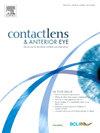Optimisation of blinking exercises for dry eye disease
IF 3.7
3区 医学
Q1 OPHTHALMOLOGY
引用次数: 0
Abstract
Purpose
Blinking exercises can reduce the signs and symptoms of dry eye disease, but the optimum technique, repetitions and repeats/day are unclear. Hence, this study used an instructional app to assess the best routine for blinking exercises.
Method
In the optimisation stage, dryness symptoms with the Ocular Surface Disease Index (OSDI-6-item), Symptom Assessment Questionnaire iN Dry Eye (SANDE), and the time the eyes were comfortable for after a blink (the Blink Test) were assessed in 98 participants with dry eye before and after 2 weeks of blinking exercises, as well as 2 weeks after completing the blinking exercise routine. Participants were randomised between a squeeze and blink compared to blink only regimen, 2 to 4 repeats per day and 5 to 25 repetitions each time. A second efficacy study with 28 participants with dry eye disease assessed the optimum app parameters based on symptom severity and frequency, blink rate/completeness, tear film stability and volume, along with ocular surface staining over the same time period.
Results
Overall, blinking exercises reduced symptomatology (p < 0.01). Including a squeeze step significantly reduced symptom frequency (p < 0.01). Forty repetitions spread over two time a day was more effective than 10 repetitions 4x/day (SANDE frequency p = 0.015). Fifteen repetitions was more effective than 5 repetitions 3x/day (SANDE frequency p = 0.008). Using the optimum blinking exercise routine of 15 repeats, 3x/day for 2 weeks, dry eye symptom severity (p = 0.001), frequency (p = 0.027), incomplete blinks (p < 0.001) and conjunctival staining (p = 0.041) significantly decreased. These readings mostly returned to baseline levels two weeks after finishing the blinking exercises (p > 0.05). However, there was no significant effect on the blink rate, non-invasive tear breakup time, tear meniscus height or corneal staining (p > 0.05).
Conclusion
Fifteen repeats of close-squeeze-open cycles, 3x/day was the optimum blinking exercise routine, reducing symptoms, number of incomplete blinks and conjunctival staining.
优化眨眼运动治疗干眼症。
目的:眨眼运动可以减轻干眼症的症状和体征,但最佳的技巧、次数和每天的重复次数尚不清楚。因此,这项研究使用了一个教学应用程序来评估眨眼练习的最佳常规。方法:在优化阶段,用眼表疾病指数(OSDI-6-item)、干眼症状评估问卷(SANDE)和眨眼后舒适时间(眨眼测试)对98名干眼患者进行眨眼练习前后和完成眨眼练习后2周的眼部干燥症状评估。参与者被随机分配在挤压和眨眼之间,与只眨眼相比,每天重复2到4次,每次重复5到25次。另一项针对28名干眼病患者的疗效研究评估了最佳应用程序参数,该参数基于症状严重程度和频率、眨眼频率/完整性、泪膜稳定性和体积,以及同一时间段内的眼表染色。结果:总体而言,眨眼运动减轻了症状(p < 0.05)。但对眨眼率、无创撕裂时间、撕裂半月板高度及角膜染色无显著影响(p < 0.05)。结论:15次闭-挤-开循环,3次/天为最佳的眨眼运动常规,可减少症状、不完全眨眼次数和结膜染色。
本文章由计算机程序翻译,如有差异,请以英文原文为准。
求助全文
约1分钟内获得全文
求助全文
来源期刊

Contact Lens & Anterior Eye
OPHTHALMOLOGY-
CiteScore
7.60
自引率
18.80%
发文量
198
审稿时长
55 days
期刊介绍:
Contact Lens & Anterior Eye is a research-based journal covering all aspects of contact lens theory and practice, including original articles on invention and innovations, as well as the regular features of: Case Reports; Literary Reviews; Editorials; Instrumentation and Techniques and Dates of Professional Meetings.
 求助内容:
求助内容: 应助结果提醒方式:
应助结果提醒方式:


